AMD 3rd Gen EPYC Milan Review: A Peak vs Per Core Performance Balance
by Dr. Ian Cutress & Andrei Frumusanu on March 15, 2021 11:00 AM ESTDisclaimer June 25th: The benchmark figures in this review have been superseded by our second follow-up Milan review article, where we observe improved performance figures on a production platform compared to AMD’s reference system in this piece.
SPECjbb MultiJVM - Java Performance
Moving on from SPECCPU, we shift over to SPECjbb2015. SPECjbb is a from ground-up developed benchmark that aims to cover both Java performance and server-like workloads, from the SPEC website:
“The SPECjbb2015 benchmark is based on the usage model of a worldwide supermarket company with an IT infrastructure that handles a mix of point-of-sale requests, online purchases, and data-mining operations. It exercises Java 7 and higher features, using the latest data formats (XML), communication using compression, and secure messaging.
Performance metrics are provided for both pure throughput and critical throughput under service-level agreements (SLAs), with response times ranging from 10 to 100 milliseconds.”
The important thing to note here is that the workload is of a transactional nature that mostly works on the data-plane, between different Java virtual machines, and thus threads.
We’re using the MultiJVM test method where as all the benchmark components, meaning controller, server and client virtual machines are running on the same physical machine.
The JVM runtime we’re using is OpenJDK 15 on both x86 and Arm platforms, although not exactly the same sub-version, but closest we could get:
EPYC & Xeon systems:
openjdk 15 2020-09-15
OpenJDK Runtime Environment (build 15+36-Ubuntu-1)
OpenJDK 64-Bit Server VM (build 15+36-Ubuntu-1, mixed mode, sharing)
Altra system:
openjdk 15.0.1 2020-10-20
OpenJDK Runtime Environment 20.9 (build 15.0.1+9)
OpenJDK 64-Bit Server VM 20.9 (build 15.0.1+9, mixed mode, sharing)
Furthermore, we’re configuring SPECjbb’s runtime settings with the following configurables:
SPEC_OPTS_C="-Dspecjbb.group.count=$GROUP_COUNT -Dspecjbb.txi.pergroup.count=$TI_JVM_COUNT -Dspecjbb.forkjoin.workers=N -Dspecjbb.forkjoin.workers.Tier1=N -Dspecjbb.forkjoin.workers.Tier2=1 -Dspecjbb.forkjoin.workers.Tier3=16"
Where N=160 for 2S Altra test runs, N=80 for 1S Altra test runs, N=112 for 2S Xeon, N=56 for 1S Xeon, and N=128 for 2S and 1S on the EPYC system. The 75F3 system had the worker count reduced to 64 and 32 for 2S/1S runs.
In terms of JVM options, we’re limiting ourselves to bare-bone options to keep things simple and straightforward:
EPYC & Altra systems:
JAVA_OPTS_C="-server -Xms2g -Xmx2g -Xmn1536m -XX:+UseParallelGC "
JAVA_OPTS_TI="-server -Xms2g -Xmx2g -Xmn1536m -XX:+UseParallelGC"
JAVA_OPTS_BE="-server -Xms48g -Xmx48g -Xmn42g -XX:+UseParallelGC -XX:+AlwaysPreTouch"
Xeon system:
JAVA_OPTS_C="-server -Xms2g -Xmx2g -Xmn1536m -XX:+UseParallelGC"
JAVA_OPTS_TI="-server -Xms2g -Xmx2g -Xmn1536m -XX:+UseParallelGC"
JAVA_OPTS_BE="-server -Xms172g -Xmx172g -Xmn156g -XX:+UseParallelGC -XX:+AlwaysPreTouch"
The reason the Xeon system is running a larger back-end heap is because we’re running a single NUMA node per socket, while for the Altra and EPYC we’re running four NUMA nodes per socket for maximised throughput, meaning for the 2S figures we have 8 backends running for the Altra and EPYC and 2 for the Xeon, and naturally half of those numbers for the 1S benchmarks. The back-ends and transaction injectors are affinitised to their local NUMA node with numactl –cpunodebind and –membind, while the controller is called with –interleave=all.
The max-jOPS and critical-jOPS result figures are defined as follows:
"The max-jOPS is the last successful injection rate before the first failing injection rate where the reattempt also fails. For example, if during the RT-curve phase the injection rate of 80000 passes, but the next injection rate of 90000 fails on two successive attempts, then the max-jOPS would be 80000."
"The overall critical-jOPS is computed by taking the geomean of the individual critical-jOPS computed at these five SLA points, namely:
• Critical-jOPSoverall = Geo-mean of (critical-jOPS@ 10ms, 25ms, 50ms, 75ms and 100ms response time SLAs)
During the RT curve building phase the Transaction Injector measures the 99th percentile response times at each step level for all the requests (see section 9) that are considered in the metrics computations. It then computes the Critical-jOPS for each of the above five SLA points using the following formula:
(first * nOver + last * nUnder) / (nOver + nUnder) "
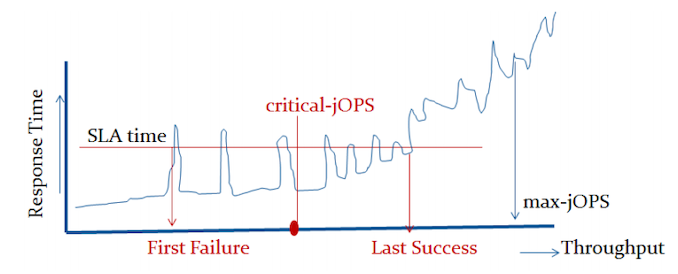
That’s a lot of technicalities to explain an admittedly complex benchmark, but the gist of it is that max-jOPS represents the maximum transaction throughput of a system until further requests fail, and critical-jOPS is an aggregate geomean transaction throughput within several levels of guaranteed response times, essentially different levels of quality of service.
Beyond the result figures, the benchmark keeps detailed track of timings of responses and tracks a few important statistical data-points across a response-time curve, as follows:
In terms of the response curves of the new Milan 7763 part, the general behaviour doesn’t look that much different to the 7742 other than a weird discrepancy at low load.
The 75F3 part is interesting as due to it focusing more on per-core performance, it tightens the response curve with the -critical performance score being closer to the -max capacity of the system.
I included the Intel and Altra graphs for context.
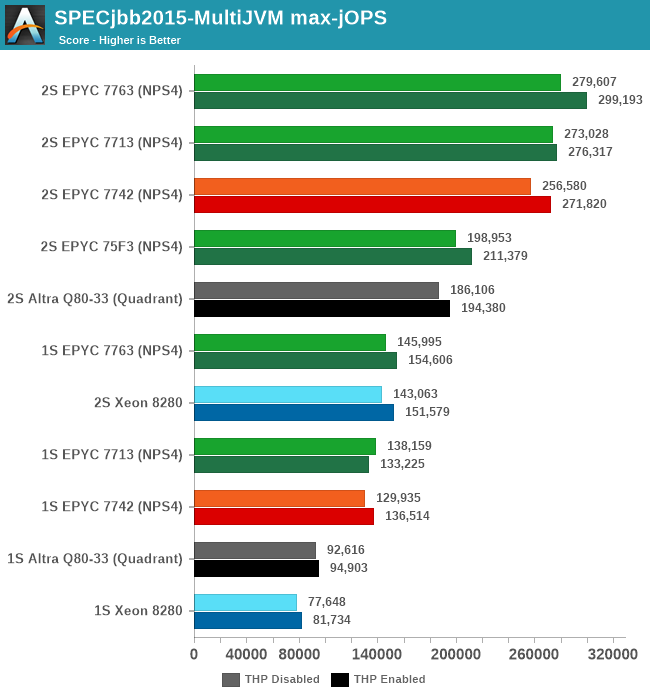
In terms of the -max-jOPS achieved by each system in our settings configuration, the new Zen3 parts fare quite well. The 7763 outperforms the 7742 by +9%, while the 7713 also outperforms the 7742 by +6.4%.
Again, very interesting is to see the 75F3’s maximum throughput reaching 71% of the top SKU’s performance in such scale-out workloads even though it’s only got half the cores available.
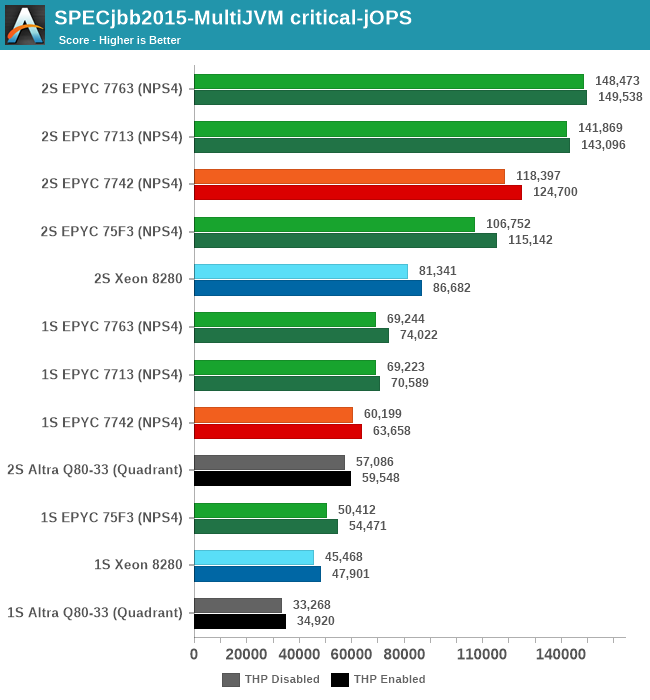
The -critical-jOPS figure is probably the more important metric for SPECjbb given that it covers SLA scenarios, and here the new Milan parts are faring extremely well. The 7763 outperforms the 7742 by +25%, and the 7713 is also not far behind with +19.7%.
The 75F3 is also doing amazingly well, keeping up with the higher core-count parts.
Against the competition, our own and AMD figures differ a bit due to different settings, however we’re still seeing the new Milan top-SKU outperform the 8280 by +82 in performance.
Generally speaking, the generational improvements over Rome in -critical-jOPS figure of SPECjbb are a more reassuring result compared to the other peak full load performance metrics we’ve seen on SPEC CPU. This actually corresponds to the power behaviour of the new chips, with the new Zen3 cores offering notably better per-core performance compared to the Rome predecessor, at least up until the new parts hit a power envelope wall where performance improvements become more limited.


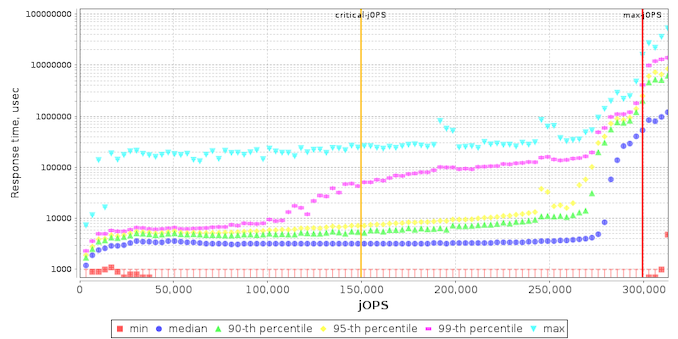

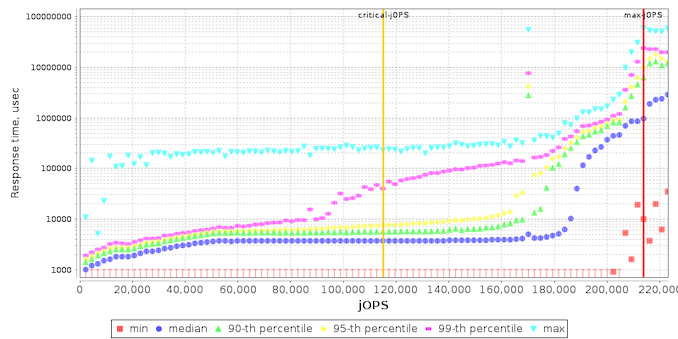
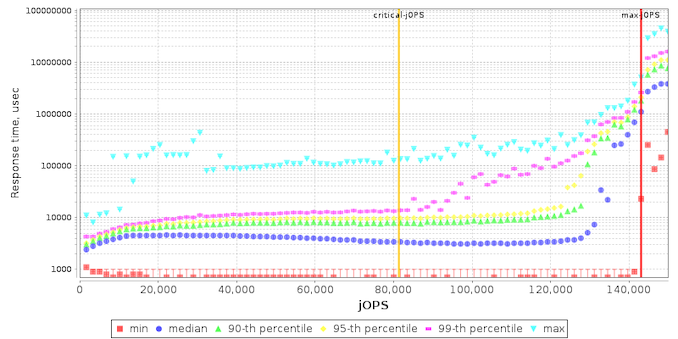
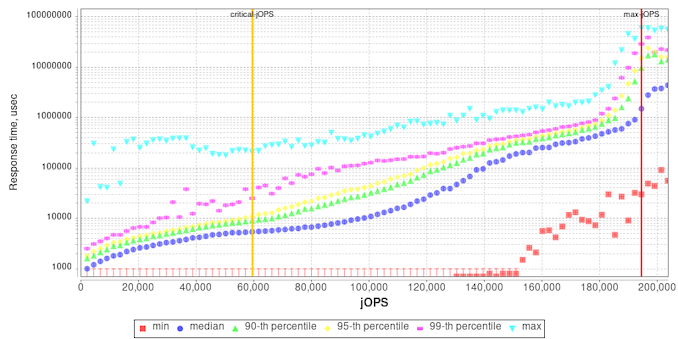
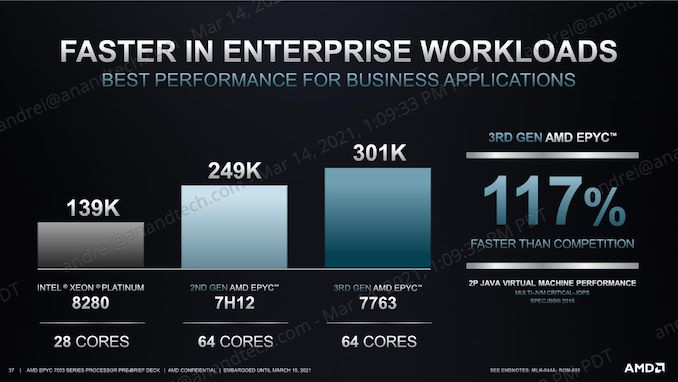








120 Comments
View All Comments
Oxford Guy - Tuesday, April 6, 2021 - link
PSP, as far as I know.Linustechtips12#6900xt - Monday, March 15, 2021 - link
I understand that "zen" architecture is for x86 but with modifications could it be transplanted to the ARM instruction set, as i see it, it definitely could so the real question is when will the transition really start i think around the theoretical zen 5th gen or 6th gen, theres gonna be a lot of arm around here especially with apple. and yes it will defenitly start wiht servers it always does.Gomez Addams - Monday, March 15, 2021 - link
There are really two things at work : the instruction set of the processor and its topology. AMD has been improving both quite a bit. The instruction set enhancements won't transfer quite so well to ARM but the topology certainly can. Since ARM processors are much smaller, they could probably work in chiplets with possibly 32 cores in each or maybe 16 cores and 4-way SMT. That could make for a very impressive server processor. Four chiplets would give 64 cores and 256 threads. Yikes!rahvin - Monday, March 15, 2021 - link
So much wrong.mode_13h - Monday, March 15, 2021 - link
There are pieces of it that can be reused (on the same manufacturing node, at least), but making a truly-competitive ARM chip is probably going to involve some serious tinkering with the pipeline stages & architecture. And there are significant parts of an x86 chip that you'd have to throw out and redo, most notably the instruction decoder.In all, it's a different core that you're talking about. Not like CPU vs. GPU level of difference, but it's a lot more than just cosmetics.
coder543 - Monday, March 15, 2021 - link
"For this launch, both the 16-core F and 24-core F have the same TDP, so the only reason I can think of for AMD to have a higher price on the 16-core processor is that it only has 2 cores per chiplet active, rather than three? Perhaps it is easier to bin a processor with an even number of cores active."If I were to speculate, I would strongly guess that the actual reason is licensing. AMD knows that more people are going to want the 16 core CPUs in order to fit into certain brackets of software licensing, so AMD charges more for those to maximize profit and availability of the 16 core parts. For those customers, moving to a 24 core processor would probably mean paying *significantly* more for whatever software they're licensing.
SarahKerrigan - Monday, March 15, 2021 - link
Yep.Intel sold quad-core Xeon E7's for impressively high prices for a similar reason.
Mikewind Dale - Monday, March 15, 2021 - link
Why couldn't you run a 16 core software license on a 24 core CPU? I run a 4 core licensed version of Stata MP on an 8 core Ryzen just fine.Ithaqua - Monday, March 15, 2021 - link
Compliance and lawsuits.You have to pay for all the cores you use for some software.
Yes if you're only running 4 cores on your 8 core Ryzen then your fine but Stata MP is using all 8, there could be a lawsuit.
Now for you I'm sure they wouldn't care. For a larger firm with 10,000+ machines, then that's going to be a big lawsuit.
arashi - Wednesday, March 17, 2021 - link
Some licenses charge for ALL cores, regardless of how many cores you would actually be using.